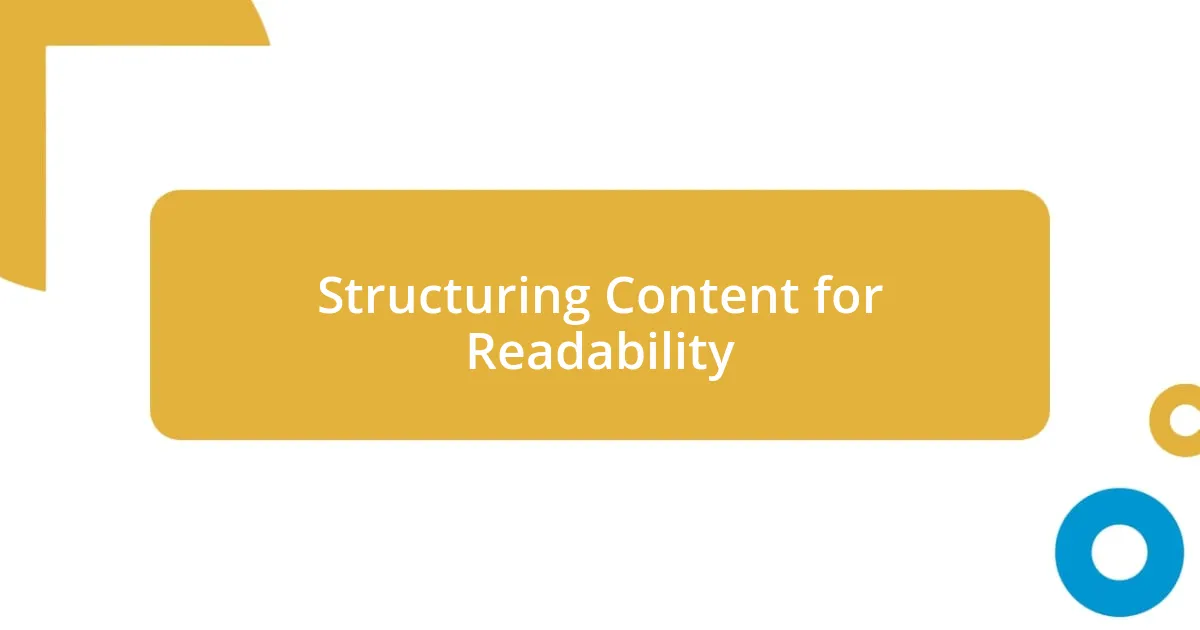Key takeaways:
- Keyword research is essential for understanding audience language and enhancing content relevance.
- Structuring content for readability, using short paragraphs and headings, significantly improves engagement.
- Crafting clear and compelling headlines, often with numbers or questions, boosts click-through rates.
- Engaging through storytelling and audience interaction fosters a deeper connection with readers.

Understanding SEO Writing Essentials
When I first delved into SEO writing, the sheer amount of terminology and techniques felt overwhelming. I wondered, “How can I make my content both appealing and optimized for search engines?” The key lies in understanding that SEO isn’t just about keywords; it’s about crafting a narrative that resonates with readers while meeting technical requirements.
One of the essentials I learned early on is the importance of keyword research. Initially, I would randomly sprinkle keywords into my writing, thinking it would suffice. However, once I started using tools like Google Keyword Planner, the difference in engagement was palpable. It’s like tuning into the heartbeat of your audience—knowing what they’re searching for provides invaluable insights into the language they use and the topics they care about.
Another crucial aspect of SEO writing is structuring your content for readability and engagement. I recall a piece I wrote where I used long paragraphs, thinking it made me sound more knowledgeable. To my surprise, the feedback indicated my readers found it daunting. So, I shifted my focus to shorter sentences and paragraphs. It was freeing! This change not only improved user experience but also positively impacted my rankings, proving that clarity and accessibility should always be at the forefront of your writing strategy.

Importance of Keyword Research
The cornerstone of effective SEO writing truly begins with keyword research. I remember the moment I realized that keywords are more than mere tools; they’re the language of my audience. By investing time in understanding the words and phrases people use, I learned how to connect with them on a deeper level. Suddenly, my content felt relevant, alive, and authentic—like having a conversation rather than writing an essay.
What struck me the most was the power of data-driven decisions. In one of my projects, I wasn’t getting the traction I anticipated. After conducting thorough keyword research, I discovered that my target audience was searching for information slightly differently than I had assumed. By tweaking my content around the right keywords, I saw a notable lift in traffic and engagement. It was a clear reminder that listening to what the audience is saying—through their searches—can lead to meaningful results.
Lastly, keyword research serves as a roadmap for content creation. It directs where my writing should focus and what topics to cover, ensuring I’m aligned with what potential readers are looking for. I find that having this clarity not only streamlines my writing process but also sparks new ideas I hadn’t considered before. Ultimately, it’s not just about searching for keywords; it’s about discovering the heart of the conversation happening online.
| Aspect | Importance |
|---|---|
| Audience Understanding | Identifying search behavior enhances connection. |
| Data-Driven Insights | Supported decisions lead to improved engagement. |
| Content Direction | Guides topic relevance and inspires new ideas. |

Crafting Compelling Headlines
Crafting compelling headlines can feel like trying to catch lightning in a bottle. I’ve often wrestled with the balance between creativity and clarity while aiming to grab attention. It’s exhilarating to brainstorm catchy phrases, but I learned the hard way that a great headline must also convey the essence of the content within. I once wrote a headline that sounded clever but confusing, and the disappointing click-through rate reminded me that clarity triumphs over cleverness if you want to engage your audience.
Here are a few techniques I’ve found useful when creating headlines:
- Use Numbers: Lists tend to draw readers in. Titles like “5 Tips for Better SEO” are straightforward and promise specific takeaways.
- Include Keywords: I make sure to weave in relevant keywords naturally; it helps with SEO and gives context.
- Evoke Emotion: I aim for titles that provoke curiosity or excitement, like “Unlock the Secrets to SEO Mastery.”
- Ask Questions: Questions engage the reader’s curiosity, like “Are You Making These Common SEO Mistakes?”
- Be Clear and Simple: I always try to avoid jargon in my headlines, ensuring they’re accessible and easy to understand.
During my journey, I encountered a memorable moment when a headline I was particularly proud of fell flat. I’d gone for a pun that I thought was clever, only to realize later that it didn’t resonate with my audience at all. It was a humbling experience that taught me to focus more on my readers’ perspectives. Now, I continuously seek feedback on my headlines, as it’s invaluable in refining my approach and finding that sweet spot between engaging and informative.

Structuring Content for Readability
When it comes to structuring content for readability, I’ve found that short paragraphs make a significant difference. Personally, there have been moments when I would glance at a wall of text and almost immediately feel overwhelmed. Breaking content into bite-sized chunks with spaces in between not only eases visual fatigue but also invites readers to keep engaging. I believe that each paragraph should ideally convey a single idea, allowing the reader to absorb information without feeling rushed.
Additionally, using headings and subheadings is a strategy that I can’t recommend enough. In my experience, these elements act like signposts, guiding readers through the content landscape. For example, I once wrote an article where I forgot to include clear subheadings. The feedback I received highlighted that my audience felt lost, struggling to navigate the main points. Since then, I’ve always embraced structured formatting, and I love how it helps highlight the key takeaways, keeping the reader’s journey seamless.
Lastly, bullet points are my go-to tool for enhancing readability. They help me distill complex information into digestible nuggets. I recall a project where I presented a complicated process in a lengthy paragraph. It wasn’t until I restructured that information into bullet points that clarity emerged, and my audience finally understood the steps. When you think about it, who has time to sift through dense paragraphs these days? Embracing visual breaks in your content, like lists or bullet points, can truly reshape the reader’s experience.

Optimizing for Search Engines
When optimizing for search engines, I’ve found that understanding keyword intent is crucial. Imagine you’re trying to rank for a phrase that you love, only to realize later that it doesn’t match what users are actually searching for. I once focused heavily on a specific keyword without considering the broader context and intent behind it. The traffic was minimal until I pivoted and focused on related phrases that reflected what my audience was searching for. This simple shift taught me the importance of consistently putting myself in my readers’ shoes.
Another aspect of SEO writing that I often emphasize is the importance of meta tags, especially the meta description. Think of it as your page’s business card; it should be enticing enough to make someone want to click through. I remember combing through my old articles, only to see uninspired meta descriptions that didn’t reflect the actual content. I started treating them as mini-advertisements, incorporating strong keywords and a call to action. This slight change boosted my click-through rates significantly, reinforcing the idea that every element of your content should work harmoniously toward the same goal.
Incorporating internal and external links is another powerful strategy I’ve learned through trial and error. Initially, I was hesitant to interrupt the flow of my writing with links, fearing it would distract my readers. However, I soon discovered that well-placed links not only enhance credibility but also guide readers through related topics. During a particularly reflective phase of my writing journey, I included a handful of internal links in a blog post about SEO best practices, and the subsequent increase in engagement surprised me. It made me realize how linking enriches the reader’s experience, providing them with a path to explore further. Have you ever wondered how many opportunities you might unlock simply by sharing a few well-placed links?

Engaging Your Target Audience
Engaging your target audience requires a deep understanding of who they are and what they value. I remember attending a webinar where the speaker emphasized the importance of building reader personas. At first, it seemed tedious, but diving into what my audience wanted helped me craft content that resonated with them. I realized that when you speak directly to their needs and interests, it fosters a connection that keeps them coming back for more.
Moreover, I’ve found that storytelling can be a game-changer in engaging an audience. I once shared a personal experience about overcoming a professional hurdle in a blog post, and the response was overwhelming. Readers reached out to me, sharing their own struggles and successes. This mutual sharing created an intimate space where we related on a personal level, proving that vulnerability can significantly enhance engagement. Have you ever considered how sharing your own stories can make your audience feel seen and understood?
Lastly, I believe that asking questions within your content invites your readers to interact actively rather than passively consuming information. Incorporating questions encourages them to pause and reflect on their own experiences. For instance, when I asked, “What challenges do you face in your writing journey?” in one of my articles, comments began pouring in. I was amazed at how this simple tactic opened up meaningful conversations, transforming my blog into a community of shared insights. Engaging your audience isn’t just about delivering content; it’s about sparking dialogue and encouraging connections.

Measuring Success and Improvement
One of the most effective ways to measure success in SEO writing is through analytics. I love diving into Google Analytics to see how my articles perform. The first time I tracked my metrics, I was both excited and anxious to see the data. It was eye-opening to notice which pieces garnered the most traffic and where readers were dropping off. This insight allows me to refine my writing and improve engagement continuously.
Another method I find beneficial is tracking keyword rankings over time. I remember when I first started using tools like SEMrush; it felt like unlocking a treasure chest of information. By monitoring how specific keywords fluctuate in ranking, I can adjust my strategy. For example, I once noticed that a piece on content strategy had slipped in rankings. Rather than ignore it, I revisited the content, updated it with fresh data, and watched its visibility grow again—a clear indication that nurturing and evolving our work is necessary for sustained success.
User feedback plays a pivotal role in my continuous improvement process. I’ve started asking readers for their thoughts at the end of my articles, and the responses have genuinely readjusted my approach. While I anticipated simple comments, I’ve received profound insights that have shaped my subsequent writing. Have you ever considered how much your audience’s opinions can guide your journey? By valuing their feedback, I’ve learned to align my content with their expectations, which fosters a rewarding cycle of engagement and enhancement.












